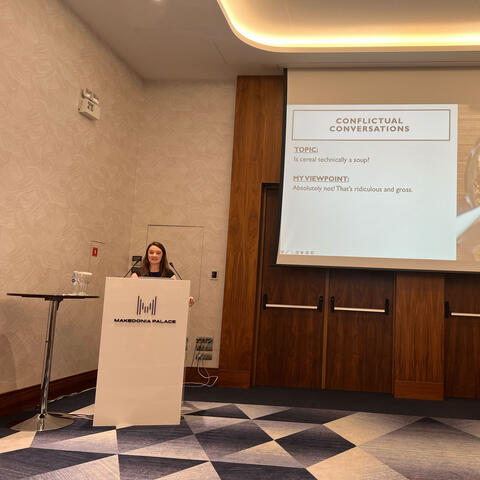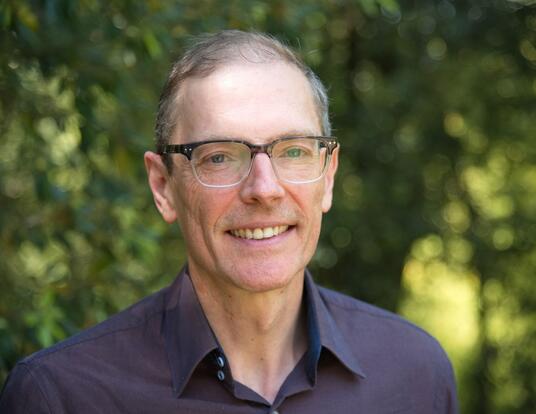Colloquy Podcast: An Air Conditioner That Won’t Warm the Planet
The global average temperature for July 2023 was the highest on record—and maybe the highest for the past 120 years, according to the United Nations’ weather agency. In the United States, temperatures in Phoenix, Arizona, reached a record 118 degrees Fahrenheit and hit highs of at least 110 degrees for 31 consecutive days—also a record. And yet the populations of Arizona, Texas, and Florida—the states hardest hit by the warming trends—continue to expand. All of those people need air conditioning and refrigeration to make life bearable, but current cooling technologies just make the planet warmer. That's why Jinyoung Seo, PhD '23, wants to reinvent the air conditioner. In this episode of Colloquy, Seo talks about how he uses solid refrigerants to eliminate cooling systems’ direct greenhouse gas emissions—all while making them smaller and vastly more efficient.
(This talk was originally given during the Harvard Horizons Symposium in 2023. The transcript below has been lightly edited for clarity and correctness.)
Imagine being in this theater on a hot summer day without air conditioning. Pretty uncomfortable, right? What you might not know is that the very technology keeping us cool is now warming the planet. Air conditioning relies on fluids called refrigerants. Most refrigerants we use today are hydrofluorocarbons, which are extremely potent greenhouse gases. As you use them, they leak into the atmosphere, trapping heat, releasing back to Earth. So now we're stuck in a vicious cycle. To adapt to the rapidly changing climate, we need air conditioning. But as we use more and more ACs, the planet keeps getting warmer. This is a big problem, but maybe not a big problem for a first-year graduate student in chemistry.
When I first arrived at Harvard, I never thought I'd be working on anything related to climate change. I was drawn to fundamental science questions. I just wanted to tinker with molecules and understand why they do what they do. And I started with the material known as two-dimensional perovskite. Why? Well, we chemists, we're visual creatures. We love 3D structures. So along with my advisor, Professor Jared Mason, I was drawn to this material simply because it looks interesting.
Two-dimensional perovskite features inorganic sheets that are formed by corner-sharing metal halide. They serve as a template to host the long organic chains. These organic chains pack into a bilayer structure. What caught our attention was that these organic bilayers can do something very strange. They're dynamic. They can switch between order and disorder. When you increase temperature, these long, fluffy chains start vibrating, wiggling, and twisting. And at around room temperature, they undergo a sharp phase transition. They expand, storing a high density of thermal energy. What is fascinating is that these chains are so disordered, they resemble molecules in a liquid.
In other words, this is a solid that behaves like a liquid. You can always transform these chains back to order by simply lowering the temperature. When you lower the temperature, these chains become frozen, releasing heat. The bilayers contract. I was fascinated by this phenomenon, and I began to synthesize a wide range of compounds featuring these organic bilayers. And I studied their phase transitions. I was using this material as a playground to explore the relationship between molecular structures and thermal energy.
Like I said, we chemists, we love to tinker with interesting structures. At the same time, this fundamental investigation got me thinking about what I could do with these unusual solids. So first, I started imagining different ways to control this transition. For example, I thought instead of using temperature, we should be able to use pressure to control their state, because these bilayers are squishy. When you compress this material, it contracts. They contract, and by contracting, they release heat. You can also reverse it by removing pressure.
When you remove pressure, they slowly expand, absorbing heat. So I was thinking about this idea. While doing so, I started reading papers outside chemistry. I came across a group of people—philosophers, engineers, and physicists—who have been studying heat and solids. And some of them had been trying to use solids for cooling. For example, squeezing certain materials can trigger a phase condition and temperature change, which can be used to move heat. But the problem is this process is often not reversible unless you apply extremely large pressure.
I found these papers interesting, but nothing really happened for weeks. But then it hit me. I realized the material that I've been studying all along—this strange solid that behaves like a liquid—might be an ideal refrigerant for cooling. These organic bilayers are compressible, and their transitions involve substantial changes in energy and volume. The combination of these properties should allow them to absorb and release large amounts of heat at low pressure. And this reversible process, when combined with a proper heat transfer system, can be used to move heat from inside to outside, providing cooling.
After I made this conceptual leap, I spent the past four years establishing this material as a new class of solid refrigerant. To study how they respond to pressure, I spent many hours in the lab performing a series of high-pressure experiments. In doing so, I was able to understand and improve their cooling performance. In one of these experiments, I measured the sensitivity of phase conditions to pressure to get the diagram—so-called a phase diagram. And using this diagram, we could also perform an experiment to directly measure the flow of heat that goes in and out of the material as we change pressure.
And using this experiment, we're able to demonstrate this organic bilayer does indeed provide a powerful mechanism for cooling. So now we're convinced that this solid refrigerant offers many exciting possibilities. By replacing this harmful gas refrigerant, we can finally break the feedback loop between cooling and climate change. We can also go beyond the climate impact. We can start reinventing air conditioning. We can develop cooling devices that are efficient and compact and, more excitingly, we can even bring this invention to places where conventional cooling technology doesn't work really well, like in outer space.
Now we are working with engineers to build a prototype cooling device. We're going to bring this discovery to life. So, this is a story of how a chemist ended up working on air conditioning. I never thought [INAUDIBLE] molecule in the lab would lead to a possible solution to climate change. But I think that's the beauty of fundamental research. It's not always clear where my exploration will lead me. But when the right connections are made, it can lead to unexpected turns with unexpected discoveries. So what's next? I don't know. What I do know is I'm excited to continue my journey as a chemist, hunting for the next discovery.
Get the Latest Updates
Join Our Newsletter
Subscribe to Colloquy Podcast
Simplecast





